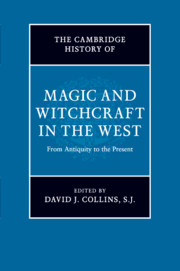Book contents
- The Cambridge History of Magic and Witchcraft in the West
- The Cambridge History of Magic and Witchcraft in the West
- Copyright page
- Contents
- Notes on Contributors
- Introduction
- Part I Antiquity
- Part II The Early Latin West
- Part III Parallel Traditions
- Part IV Old Europe
- Part V Colonial Encounters
- Part VI The Modern West
- Chapter 17 Magic in Common and Legal Perspectives
- Chapter 18 Elite Magic in the Nineteenth Century
- Chapter 19 Magic in the Postcolonial Americas
- Chapter 20 New Age and Neopagan Magic
- Bibliography
- Index
Chapter 20 - New Age and Neopagan Magic
from Part VI - The Modern West
Published online by Cambridge University Press: 05 March 2015
- The Cambridge History of Magic and Witchcraft in the West
- The Cambridge History of Magic and Witchcraft in the West
- Copyright page
- Contents
- Notes on Contributors
- Introduction
- Part I Antiquity
- Part II The Early Latin West
- Part III Parallel Traditions
- Part IV Old Europe
- Part V Colonial Encounters
- Part VI The Modern West
- Chapter 17 Magic in Common and Legal Perspectives
- Chapter 18 Elite Magic in the Nineteenth Century
- Chapter 19 Magic in the Postcolonial Americas
- Chapter 20 New Age and Neopagan Magic
- Bibliography
- Index
Summary
- Type
- Chapter
- Information
- The Cambridge History of Magic and Witchcraft in the WestFrom Antiquity to the Present, pp. 635 - 664Publisher: Cambridge University PressPrint publication year: 2015
- 2
- Cited by

